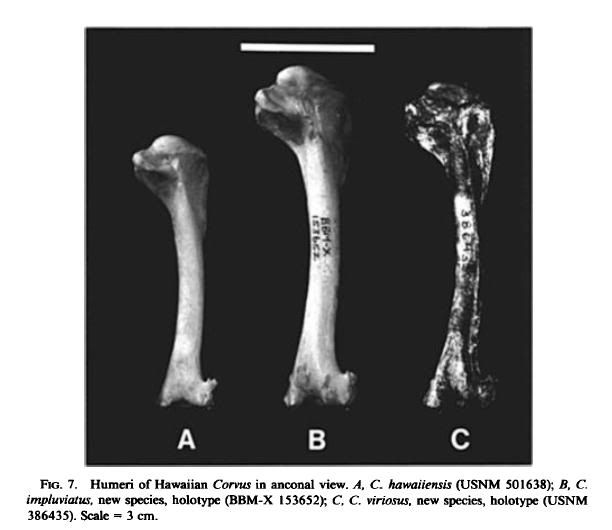Post by another specialist on Jul 22, 2006 7:19:38 GMT
SYSTEMATIC PALEONTOLOGY
Order PASSERIFORMES
Family CORVIDAE
Genus Corvus Linnaeus, 1758
Order PASSERIFORMES
Family CORVIDAE
Genus Corvus Linnaeus, 1758
Two new species of crows in lowland fossil sites on Oahu and Molokai (Olson
and James 1982a, b, 1984) are known from associated fossil skeletons preserved
so well as to rival the best skeletal preparations in modern museum collections.
These fossils were collected under water in a flooded cavern near Barbers Point,
Oahu. We have designated specimens from this cavern as the holotypes for both
of the new species, although one of the species is known so far from Oahu only
from the holotype, and occurs far more abundantly in the dune sites on Molokai.
Bones of crows have also been found in lava tubes on Maui (James et al. 1987)
12 ORNITHOLOGICAL MONOGRAPHS NO. 46
and Hawaii. These are all isolated elements or fragmentary skeletons that need
further study before they can be identified to species with reasonable assurance.
We compared the new Hawaiian crows to all other species of Corvus that occur
in the Pacific Basin and peripheral continental areas, except two geographically
restricted species for which specimens were not available.
To simplify our diagnoses, we can eliminate the following species from further
discussion. The new Hawaiian crows are markedly larger than Corvus dauuricus,
C. moneduloides, C. enca, C. typicus, C. kubaryi (bill also narrower), C. frugilegus,
C. brachyrhynchos, C. caurinus, C. imparatus, C. orru, C. torquatus (bill also less
deep), or C. cryptoleucus. The bills of the new species are deeper than in C.
coronoides, C. mellori, C. torquatus, or C. validus. Compared to the new species,
Corvus corone has the ventral surface of the maxilla less excavated, the nostril
longer, and the bill less deep; C. bennetti has a smaller bill; and C. tristis has the
mandible less deep and the sternum relatively large in proportion to humerus
length.
Comparative material examined: The complete skeleton of Corvus hawaiiensis
that we used in our comparisons, USNM 501638, is from an atypically small
male bird. We supplemented this specimen by vemoving the skull, mandible, and
several long bones from the skin of a large male ofC. hawaiiensis, USNM 177993.
Specimens of C. fiorensis (restricted to Flores in the Lesser Sundas) and C. fuscicapillus
(restricted to parts of New Guinea and its satellites) were not available
for comparison. Skeletal material from the Smithsonian collections included: C.
dauuricus male, 292083; females, 292082, 319401. C. moneduloides male, 561635;
female, 561634. C. enca male, 225830; unsexed, 224802. C. typicus male, 226205
(trunk only). C. kubaryi unsexed, 613280. C. validus males, 557299, 557300,
558297; females, 489028, 557301. C. tristis female, 489028. C. frugilegus males,
290314, 291673. C. brachyrhynchos male, 554206; female, 499510. C. caurinus
males, 561899, 612996; females, 612993, 612995. C. corone male, 500773; unsexed,
289948. C. macrorhynchos males, 290456, 292081, 500768; females,
290955, 500774; unsexed, 318366. C. orru male, 559044, females, 558338, 559045.
C. torquatus males, 289947, 291412, 292078; female, 292858. C. cryptoleucus
males, 553971, 553972, 553973, 555254; females, 498679, 554139. C. corax
males, 489704, 499938; female, 555261; unsexed, 18622, 290441. Of C. moriorum,
we examined the following subfossil specimens: NMNZ S 962, skull and
partial skeleton; AU 6120, partial postcranial skeleton; AU 6121.16, mandible;
CMC AV3310, skull and partial skeleton. We also made comparisons with study
skins of the following species in the Smithsonian collections: C. hawaiiensis (12
specimens), C. woodfordi, C. meeki, C. imparatus, C. bennettL C. coronoides, and
C. mellori.








